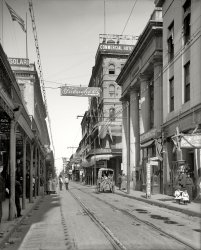
MAY CONTAIN NUTS

Search Shorpy
SHORPY ART

Framed or unframed, desk size to sofa size, printed by us in Arizona and Alabama since 2007. Explore now.
Join and Share
Ad-Free Shorpy
Shorpy is funded by you. Patreon contributors get an ad-free experience.
Learn more.

Recent comments
- "Peck turned a sweet propeller"
- National Bank Building
- Notch shot
- Straight ahead (right, left, left, right)
- Ship lifespans
- New service
- You Say Station, I Say Potato ...
- Iron Age
- Thank you, Cornelius Vanderbilt
- Grand Central Terminal
- If they made a movie of it
- Obsolete by then.
- Half the tonnage at the NYPANO dock
- Ravages escaped, bank notes signed and dated
- Chatham expansion
- Steepled in History
- Made by York
- No Summer Vacation
- Wait a minute ...
- $$$
- Joad on the Road
- Street Lights Survive
- Now & then
- More or Less? It's a lot less
- A new image.
- Same ol' story ...
- $13,589,422,507.55 in 2024 dollar$
- Skinned knuckles
- Not enough
- Completed, and then enlarged
Member Photos
The Shorpy
Printporium
Printporium
Search Shorpy
Search results -- 30 results per page
- Afternoon of the Dead: 1895
- Circa 1895. "Metairie Cemetery, New Orleans." 8x10 inch dry plate glass negative, Detroit Publishing Company. ... grave of family members and encounter others they knew (New Orleans was a small town, and still is in many ways) and sit and chat.
... Posted by Dave - 08/02/2012 - 3:17pm -
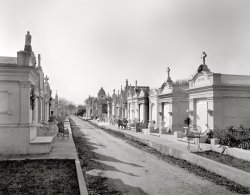
- Good Eats: 1937
- ... Administration. View full size.
Could be in New Orleans…. In New Orleans a husband would take a To-Go oyster Poor Boy (or loaf, which was ... Posted by Dave - 07/26/2014 - 12:41pm -
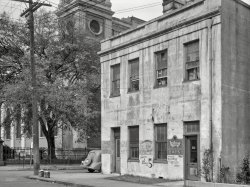
- Canal Street: 1890s
- New Orleans in the 1890s. "Canal Street from the Clay monument." Dry-plate ... man to stand in the way of progress.
Infrogmation of New Orleans
A Streetcar Named Electric The switch to electric streetcars ... than a year for changes to be made. They were delivered to New Orleans starting in 1896.
Strings and Things Pianos and Ladies' ... Posted by Dave - 11/14/2012 - 11:46pm -
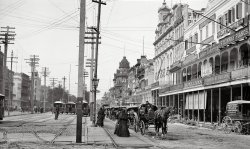
- The Old French Market
- Circa 1880s-1890s. "The old French Market, New Orleans." Photo by William Henry Jackson. Detroit Publishing Co. glass ... in the center of the photo.
Last time I was in New Orleans, 25 years ago, there was at least one long-established grocery ... is in the high ground area, such as it is, of earliest New Orleans settlement, and probably didn't get flooded after Katrina, although ... Posted by Dave - 03/13/2019 - 10:53pm -
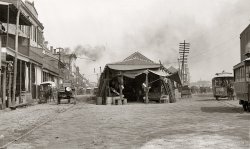
- Oyster Luggers: 1908
- New Orleans circa 1908. "Oyster and charcoal luggers in the old basin." 8x10 ... that the type is actually a survivor from the period when New Orleans was a French colony? Howard I. Chapelle, in "American Small ... work-boat type in the late 19th century." A plan of a New Orleans lugger is figure 104 in Chapelle, and it looks almost exactly like ... Posted by Dave - 08/08/2012 - 2:02pm -
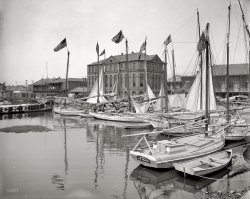
- Horsecar Opera: 1890
- New Orleans circa 1890. "The Clay Monument, Canal Street." Fascinating details ... in 1860.
In 1890 he was under Durieu Management in New Orleans along with other principal singers. In January 1891 he was in ... "Lucia di Lammermoor" at the French Opera House in New Orleans. He later returned to New Orleans in 1901 and was under Roverval ... Posted by Dave - 08/14/2012 - 3:42pm -
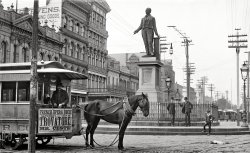
- Absinthe Room: 1906
- New Orleans circa 1906. "Old Absinthe House -- the bar." No obvious patrons ... me in the least to see one turn up in an absinthe house in New Orleans.
Sanded Floors
Odd Corners, by Isabel Anderson, ... taken anything at all.
Standard History of New Orleans, Louisiana, 1900.
Restaurants
Two drinks that are ... Posted by Dave - 08/05/2012 - 4:28pm -
![Absinthe Room: 1906 New Orleans circa 1906. "Old Absinthe House -- the bar." No obvious patrons except for a number of barflies. Detroit Publishing glass negative. View full size.
Distilled since 1830.Bottom shelf, second bottle from the left. "Old Crow" was General Grant's favorite whiskey. Also favored by Mark Twain and Henry Clay.
The Green Fairy has left the room.Maybe she will appear after a few more sips.
Absinthe fountainsThose tall counter fixtures with faucets appear to be rather hefty looking absinthe fountains. They slowly drip cold water into your glass of absinthe to enhance the color and flavor.
And it looks like there's sand or sawdust on the floor. Clearly it's there to make it easier to clean up the blood from absinthe-induced barfights, just like in the old gladiatorial arena.
Faux FinishThat's a faux finish on the wooden bar. Most wood used in N.O. was cypress dressed up to look like another wood, usually oak. Mighty fine job of fauxing.
Brassiere on the Camel?I love how the top of the pillar looks nicely carved and artfully decorated and the bottom looks like an old telephone pole.
Some great fixtures in this room: stove, taps, lights, fans, etc. So much detail that just isn't appreciated any more.
Anybody know what the little cabinet(?) above the Red Raven Spirits sign is for? It's electric, whatever it is.
Bourbon Street BeatWhy, Cal Calhoun, Rex Randolph and Kenny Madison had their offices just above this place. The lovely Melody Lee Mercer was their secretary/Girl Friday. Last I heard, Rex had moved to L.A., out on the strip and Kenny was on a houseboat in Miami. Cal, never heard of him again, probably still sippin' absinthe.
Beaux artsI suspect, though I cannot confirm, that the artwork to the left of the clock behind the bar is a hand-colored print by the artist Vincent de Paredes. His prints of French royalty and the such were quite popular at the turn of the century, and it wouldn't surprise me in the least to see one turn up in an absinthe house in New Orleans.
Sanded Floors
Odd Corners, by Isabel Anderson, 1917.
Round the Gulf
Another time our friends took us down Bourbon Street and stopped near the old "Absinthe House," which, as it was supposed to be closed on Sunday, we entered by the back door! It is one of the most picturesque houses in the world—there is nothing more interesting in Paris—with its sanded floors and little tables and the curious people who frequent it. No wonder the mixture of absinthe is so dangerous, for it makes you feel so well, yet you do not realize that you have taken anything at all.
Standard History of New Orleans, Louisiana, 1900.
Restaurants
Two drinks that are peculiar to New Orleans are the "roffignac," said to have been invented by the Marquis de Roffignac, one of the celebrities of the early days; and absinthe, which is also drunk in Paris. It is found at the old Absinthe House at the corner of Bourbon and Bienville streets, which was built in the year 1752, and which has been an absinthe house since 1826.
SawdustWhen I was a child there was a supermarket in Brooklyn called Packers that had sawdust on the floor throughout.
You see sawdust here. You see it in old photos of butcher shops. Even the Southern California restaurant chain Chris and Pitts had sawdust covered floors in its early days.
The sawdust was taken away from Packers in the mid 1960's, supposedly because it was considered a fire hazard. I do not know when Chris and Pitts got rid of theirs, but none of the surviving outlets have any sawdust on their floors any more.
Clearly people thought that putting sawdust on a floor did something good for them. I have no clue what they thought it did other than give fires a place to smolder, and patrons a slippy surface to slide and fall on.
[The sawdust soaked up various expectorants, tobacco juice chief among them, and no doubt other fluids. - Dave]
That PanelCould it be an annunciator panel of some sort to signal that someone in another area has runout of libation and requires a refill?
Thank you Evelyn WoodWhen I first read the title of this photo, I read it as "Abstinence House." I thought to myself, if a fellow can resist temptation in here, he is cured!
(The Gallery, DPC, Eateries & Bars, New Orleans)](https://www.shorpy.com/files/images/4a10807a.thumbnail.jpg)
- Cathedral Mansions: 1924
- ... made it obsolete. Some Creole families and merchants in New Orleans used brick dust for the same reasons.
Sawdust They would put ... Posted by Dave - 09/03/2012 - 6:51pm -
![Cathedral Mansions: 1924 Washington circa 1924. "Cathedral Mansions Grocery." The market at Cathedral Mansions, a multistory apartment complex on Connecticut Avenue that also had its own bakery and drugstore. View full size. National Photo glass negative.
Sawdust on floorsAbsorbed spills. Generally it was swept up each day and replaced with fresh. Very common in shops & bars of the period.
Butter and Egg MoneyButter at 47 cents a pound is equivalent to more than $5.60 a pound in 2008 dollars so we are doing OK on that front.
Even better, if that big can of Criso is four pounds at $1.40, that's equivalent to almost $17 today. In fact, a 4 pound can of Crisco today costs less than $6.
Good old days indeed!
CocoaThey seem to stock at least six different kinds of cocoa.
Campbell'sCampbell's Soup and Wrigley's Gum have not changed much if at all (except the price obviously). I wonder if the A&P tearsheet behind the register is for comparison purposes or was this store part of that chain?
Dusting it upSawdust caught a lot of the detritus that fell to the floor, and made it easier to sweep up at the end of the day.
Whoa, look at those melons.Whoa, look at those melons. Also, I see Kellogg's was pushing bran even back then.
SawdustWhat is the reason for all the sawdust on the floor? At least I hope it is sawdust.
SawdustIf I recall, it was on the floor to make cleanup at the end of the business day easier. The streets weren't exactly clean in those days. The sawdust would absorb whatever was tracked in and at closing, you'd just sweep up and throw away what got dirty and then lay down some more.
SawdustSawdust was used to absorb dirt, mud and grease. At the end of the day, the old sawdust would be swept up and new sawdust laid down. It was also used in bars for a very long time. Eventually, concerns about flammability from dropped cigarettes and improved flooring made it obsolete. Some Creole families and merchants in New Orleans used brick dust for the same reasons.
SawdustThey would put sawdust on the floor because it would absorb the liquids that would fall, making for a easy clean up at the end of the day.
Sawdust reduxMy down-South 60s school custodians used sawdust to sweep the floors. They had big bins of it stored outside the building and I recall us looking in them from time to time. The sawdust seemed wet because it was oily and the combination of sawdust and oil smelled great.
Think about it - faster than wet mopping, absorbed moisture, soft on flooring, and most of all no dust scattered from dry sweeping method (it picked up fine dust and dirt before it can hit the air and settle back). Ideal. I'd order a bin today to tackle our wood floors, pet hair, and teen boys residual in the house.
Sawdust.2Sawdust has long been used on floors to pick up spills. At the end of the day you sweep it out and throw some clean sawdust on the floor for the next day. Ever been in an old-time bar with sawdust on the floor?
Look at the size of the watermelons!
Cheap corn flakesWow...Kellog's Corn Flakes for 10 cents. Wonder what's under lock and key up in that skylight?
SawdustWikipedia has everything! In the article "Floor cleaning," in the section "Methods of floor cleaning," it says: "Sawdust is used on some floors to absorb any liquids that fall rather than trying to prevent them being spilt. The sawdust is swept up and replaced each day. This was common in the past in pubs and is still used in some butchers and fishmongers." I found this through Google, of course.
Received fresh dailyI believe that in those days before modern packaging it was common for many substances to leak, for example the "choice meats" would tend to bleed thru the paper sacks.
SawdustIn butcher shops (which this is), it catches drips of blood or fat to prevent the floor from getting slippery, and makes it easier to clean up.
That's a dang big scan! Good idea to get a jump on everybody asking for enlargements of certain products.
A & P Bulk BinsThe bins with lids behind the cash-register counter belie the fact that this is an A & P store. I wonder is service was as slow then as they are near me...possibly the store employee is on a higher floor delivering a brown bag of telephoned-in items for the truly cosmopolitan urbanite.
Hmm.Why is there sawdust on the floor?
Paper or Plastic?No plastic bags back then. Check out how all the bread is wrapped in waxed paper.
Zero Scoops"Now You'll Like Bran!" I see five bran choices, mostly Kellogg's, and none includes raisins. Many wheat and corn options too. Mr. Kellogg must have been proud, as he was still alive at this time.
Where's waldo (a.k.a. the Sun-Maid girl)?The Sun-maid company has a cute history of the Sun-Maid girl: "In 1915, the brand name SUN-MAID was launched, and within a year, executives of the company discovered a local girl, Lorraine Collett Petersen whose smiling face, red sunbonnet, and tray of fresh grapes would become synonymous with the sun-dried goodness of California raisins."
TemperatureMy grandparents used to cook with Crisco exclusively, just scooping it out by the pound. I remember when I was little getting it confused with sour cream. The reality was not pleasant.
I notice the packages of eggs on the counter stored at room temperature. How long do eggs last unrefrigerated?
[How long do they last warmed up under a hen? - Dave]
Hot MothersAs a youngster, I couldn't help but notice that lots of my friends did indeed have hot mothers but in today's connotation, they would have had great advertising potential with that name. Also notice the cracker barrel in the right at the end of the meat counter and the jars of (probably) olives, pickles, green tomatoes, pickled pigs feet and pickled eggs on top of the meat counter. To the person who asked about fresh eggs kept at room temperature, my grandmother kept hers in a glass bowl at room temp for several days and none of us ever got sick. Of course she also left the Thanksgiving turkey on the back porch since it could never fit into the icebox. (We did not ever need any of the BRAN stuff).
Saw what ?I suspect Dave to have kept all these redundant answers to the intriguing question of the sawdust on purpose, just waiting for someone to ask it again.
CalasOK, I know what hams, strip bacon and fatbacks are, but what the heck are calas? Or are my old eyes failing me?
[Cala is short for California ham. Which is not really a ham but a pork picnic shoulder. Also called a "callie." - Dave]
(The Gallery, D.C., Natl Photo, Stores & Markets)](https://www.shorpy.com/files/images/32851u_9.thumbnail.jpg)
- Texas Bodega: 1939
- ... it was a product of the Southern Syrup Co. of New Orleans. - Dave]
Dippin' Snuff Seeing those tins of Garrett's ... Posted by Dave - 01/16/2022 - 7:23pm -
![Texas Bodega: 1939 March 1939. "Small Mexican grocery store. San Antonio, Texas." Medium format acetate negative by Russell Lee for the Farm Security Administration. View full size.
Old Anheuser-Busch productI love looking at pics of old stores like this. I noted the A-B Table Syrup 4th shelf all the way to the right. I wonder when that item stopped being marketed.
[It was advertised in newspapers as late as 1945. - Dave]
SaxetAs every Texan knows, that's Texas spelled backwards. Best known today as the name of a never-ending gun show, and don't you dare call it "dainty". (I mean, personally I don't mind if you call it dainty, but other people might.)
Staples, not convenience foods, but noteworthy also the number of kerosene lamp chimneys. Granted, these items are easily broken, but San Antonio was and is a major city, and major cities had electricity long before 1939. An ill-served non-electrified enclave? Emergency lighting? Or just dead stock?
Let me have one of those cans of Chuck Wagon… a ballpoint pen, and one of those Kiltie Pops there, a pint of Old Harper, a couple of flashlight batteries and some beef jerky.
CornucopiaI'll have one of everything, por favor.
The more things change --What strikes me most about this photo is how little many brands and labels have changed over 82+ years!
Don't make me come over that counterI don't see price stickers on anything and remember the days when a cashier simply knew the price of most items. Customers would let them know if a price seemed out of line. On each vertical divider is a paper clip, each holding a different type of paper. One looks like a receipt. Does anyone know what those were for?
I give this cashier a B+ on stacking merchandise. But it offends my anal retentive sensibilities that the cans of PET Milk are not all facing forward, and the one can of K C 5 Baking Powder turned backwards is driving me crazy. Don't even get me started on the salt.
So cows are now pets?The cans of milk in the upper right corner of the shelf might make one think so.
IconsAunt Jemima's makeovers didn't take, so she was retired (image, name, and brand) in 2021. The Argo corn starch maiden has been diminished and her American Indian identity downplayed. The Quaker, looking a bit smug, no longer greets us with open arms. Brer Rabbit has been pushing syrup since 1907, but competitors Teddy and Mary Jane have given up. The Pet milk cow continues to peek out of her can. Our Mother is enjoying retirement, though she worries about what Texas Girl gets up to.
Is this store in Mexico or Texas, or is this before the Alamo?How is this a "Mexican grocery store?" The products are US products and the labeling is in English.
[It's in the Mexican section of San Antonio and is owned by a Mexican. - Dave]
Responding to a comment. Yes, the clerk and the clients may know all the prices, but we wouldn't put up with such a limited selection. We may have too many choices now, but I'm not ready to go back to beans, rice and white bread.
Couldn't find out why the name "Pet." Wikipedia and the Pet website provided no explanation.
[In 1923, the Helvetia Milk Condensing Company was renamed the Pet Milk Company after its signature product, "Our Pet" Evaporated Cream. - Dave]
Mr. Monk would not approveThere are many things in this photo that bother the OCD in me.
What would be... inside those small tied up packages on the bottom shelf?
Post Toasties Corn Flakes...in Reverse!On the top shelf, it appears the Corn Flakes boxes were turned around, with the back showing the awesome crafts and giveaways, being promoted by Walt Disney!
Product DesignMy eye was immediately drawn to the glass jars, each shaped beautifully in their own way.
Texas GirlWhat a fantastic catalogue of extraordinary words contained within the array of products on these shelves: Chuck Wagon, Ole Reliable, Saxet, Our Mother’s, Argo, Aunt Jemima, Popeye the Sailor, Apex, Mary Jane, Brer Rabbit, Jefferson Island, Excelo, Teddy Bear, Lamo Lye, Rinso, Lux. My favorite is Texas Girl.
Anything and everything in a canExcept lettuce.
If you pleaseI will have a Derby Sugar Shaker Jar and one of those unmarked brown paper packages tied up with string. Then I will offer to, free of charge, organize all of the cans and boxes so that nothing is upside down. Drives me crazy. Right the Rinso already!
Calling all artistsThis is just *screaming* for colorizing. Any takers?
Almost eponymousIt was my desire to devise a clever jape over the possibility that Mr. Russell Lee had purchased a can of R. Lee's Special Sauer Kraut at this emporium, but alas, after downloading the full-size tiff from the LOC, I found my hope dashed by a vagrant reflection.
A.R. Lee's Special Sauer KrautFor TTerrace, here is an actual label, that would have been on the can.
Sure enough, one had sold on eBay!
Must be a Texas thing.Anybody know what "Kiltie Pops" are? It seems that the box has been up there for awhile.
Quite a selectionLots of beans, lots of crackers. What surprised me is the mentholated tobacco. Kool's ancestor?
A-B SyrupThe photo was taken some five years after Prohibition ended. Perhaps it was one of the products made by the brewer to get by until the Volstead Act was abolished.
That product might have been on the shelf for five years?
[A-B Syrup was being sold well into the 1940s. Branding notwithstanding, it was a product of the Southern Syrup Co. of New Orleans. - Dave]
Dippin' SnuffSeeing those tins of Garrett's Snuff on the shelf in front of the match boxes reminds me of an old fellow who ran a small engine repair shop in my East Texas hometown. He fixed lawnmowers and tillers and chainsaws and such out of a barn behind his house on the outskirts of town, just a couple miles from the Red River bottoms north of Texarkana.
I cannot recall the gentleman's name, but he had to be nearing 80 years in the 1970s. He dipped that Garrett snuff and would stand at his workbench while sharpening a mower blade and kept a Coke bottle at his feet and would spit a long string of brown tobacco juice right into the bottle without any spittle running down the outside of it. Every time. He never missed. It was pure poetry. He'd stop mid-sentence and "ssspt" into the bottle and resume his soliloquy without missing a beat.
He kept little screws and washers and nuts and carburetor parts in those snuff tins up on a shelf above his workbench. I don't think I've seen one of those snuff tins since, but this photo took me right back there in that old man's barn.
Goober Pea
(The Gallery, Russell Lee, Stores & Markets)](https://www.shorpy.com/files/images/SHORPY-8b21314a.thumbnail.jpg)
- Uneeda Baby: 1937
- New Orleans circa 1937. "Dumaine Street at Bourbon." Momma's balcony scene. ... Terra-cotta foundation ventilators. Lots of em in New Orleans.
Stoops, Not Steps I am a Shorpster from New Orleans, and the wooden stoops are attached to the buildings. Some have ... Posted by Dave - 08/14/2012 - 3:55pm -
![Uneeda Baby: 1937 New Orleans circa 1937. "Dumaine Street at Bourbon." Momma's balcony scene. 8x10 inch safety negative by Frances Benjamin Johnston. View full size.
A closer lookThe house on Dumaine in the 21st century.
Step Right UpThe steps in front of the doors look as though they were designed to be picked up and carried. In the new photo posted here they look to have been replaced with brick and cement. Any Shorpsters in NO know about the steps?
Now the Biscuit Palace Guest Househttp://www.biscuitpalace.com/
Happily, the old Uneeda Biscuit sign remains.
Building There, Baby Gone.View Larger Map
The oval thingsTerra-cotta foundation ventilators. Lots of em in New Orleans.
Stoops, Not StepsI am a Shorpster from New Orleans, and the wooden stoops are attached to the buildings. Some have been replaced with cement analogs over the years, but are still called stoops. I have stood where that lady is standing, a friend of mine owns that guest house.
StoopsInteresting that the popular New York-ism "stoop" should be used in New Orleans. The word originally comes from the Dutch "stoep," meaning small front porch or steps.
Oval VentsThose grilles are usually cast iron.
Before and after KatrinaThis is an area I have spent a lot of time in over the years and the Uneeda sign is one of the best examples of old painted advertising in the French Quarter.
Unfortunately as with many things in New Orleans, Katrina wasn't kind to it, but it is still there.
I am posting one picture I took in 2003 and another I took in 2006. You can see there was damage to the building and unfortunately, some really crappy reconstruction of the damage.
Stoops on the BanquetteA lot of the stoops throughout the city are still in use today and many more are wooden. Some people replace them with brick or cement for aesthetic preferences. The sidewalks are referred to as banquettes in New Orleans. The character Santa Battaglia mentions in "A Confederacy of Dunces" of how in the summer in her childhood the family would often spend all evening on the banquette until midnight when the house finally cooled down enough for them to sleep. In many areas of the city, family and friends still spend evening chatting, drinking, and resting on their stoops or in kitchen chairs on the banquette. The oval vents are still prolific throughout the city and help release hot air trapped under the houses but are horrible when the winter wind blows through. The roof over-hangs that jut out over the sidewalks are referred to as "abat-vents" (a-bah-vonts) creole french for "windbreakers" They helped direct the breeze into the house and kept rain out.
Three days ago!I shot this just this week.
Biscuit PalaceMy wife and I rented the room that leads to the balcony that that woman is standing on.
http://www.biscuit-palace.com/
This Property Is CondemnedI was watching the movie "This Property Is Condemned" with Natalie Wood and Robert Redford, and caught sight of this building. I was kind of excited to recognize a landmark that you all had presented in the site.
[You have a sharp eye (and memory). - Dave]
(The Gallery, F.B. Johnston, Kids, New Orleans)](https://www.shorpy.com/files/images/01259u.thumbnail.jpg)
- Biloxi Bakery Circa 1930
- ... goods. Fred Klein Sr., the founder, claims when he left New Orleans at the turn of the century, they forgot how to make REAL french ... for his claims as some of the deliveries were made to New Orleans! His bread was even flown to California and New York when visiting ... Posted by FredKlein - 08/05/2007 - 12:04am -
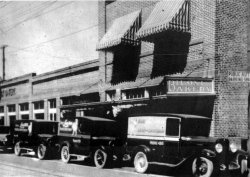
- Crescent Limited: 1926
- ... the Crescent on a daily basis between New York City and New Orleans. It's even slightly quicker now. When the service was inaugurated in 1926, the journey from Washington to New Orleans required 33 hrs and 55 minutes. Today, thanks to 87 years of ... Posted by Dave - 07/13/2013 - 9:42pm -
![Crescent Limited: 1926 Alexandria, Virginia, circa 1926. "American Locomotive Co. -- Southern R.R. Crescent Limited 1396." Seen here from the other side, with more info in the comments. National Photo Company Collection glass negative. View full size.
So little stock, so high the rentHow much would the shoes have been to pay the rent? It doesn't look like a high volume place and the selection is very small.
[Probably didn't even make enough to pay for the coal. But at least they could move to a new location easily enough. -tterrace]
OOPs: Intended for the 'Juvenile Footwear'.
Daily CrescentAmtrak still operates the Crescent on a daily basis between New York City and New Orleans. It's even slightly quicker now. When the service was inaugurated in 1926, the journey from Washington to New Orleans required 33 hrs and 55 minutes. Today, thanks to 87 years of innovation and investment, the trip will only take you 26 hrs and 2 minutes!
Washington Post, May 7, 1933.
Crescent Limited Sets Up Records
Running on a faster schedule than in any previous year, the Crescent Limited, ace of the Southern Railway System's passenger train service between New York, Washington, Atlanta and New Orleans, broke all records for on-time performance in the year ended April 25, 1933, the eighth of its operation.
Out of the 365 trips in each direction the Crescent Limited reached Atlanta on time southbound on 360 days, or 98.6 percent, and reached Washington on time northbound on 357 days, or 97.9 percent. This brought the on-time performance for eight years up to 98.3 percent southbound and 96.4 percent northbound. On April 25 the Crescent Limited was placed on a schedule of 15 hours and 5 minutes between Atlanta and Washington, 20 hours and 10 minutes between Atlanta and New Your, and hour having been cut from the running time in each direction between Atlanta and Washington.
The Crescent limited is operated over the Pennsylvania Railroad between New York and Washington, the Southern between Washington and Atlanta, the West Point Route between Atlanta and Montgomery and the Louisville & Nashville between Montgomery and New Orleans.
SmileThat's one happy locomotive.
The "Hudson"The first 4-6-4 in America was built for the New York Central by ALCO and named after the river it ran. It proved it be such a popular configuration between 1920 and 1940 they were in use by 21 American railroads (and many more overseas) -The Canadian Pacific was its second most user. Various railroads built these in their own shops and called them by assorted names, but Hudson prevails. In their day they set two speed records. However, in the '40's the clear superiority of the diesel sent these to the scrap yards. A great steam engine; pulled the 20th Century Limited in its day.
This locomotivewas painted green.
It's beautiful!Most engines, at least this side of the water, were very much 'cleaner' in appearance than the Hudson ... but this engine appears to proclaim to the world that it is a very tough and powerful machine. To my eyes, it looks wonderful ... an amazing array of 'stuff' and 'things' just hung on the outside of the locomotive, all of it going to make this one purposeful-looking machine. And, presumably, maintenance was easier.
As for those punctuality rates; they make UK rates today look pretty poor, despite ultra-modern electric traction, computers, and the like. The people who operated the services all those years ago were evidently made of the 'right stuff'. How things have ... progressed.
PacificThe previous post regarding the "Hudson" class of locomotive on the NYC are effectively correct including the mention of the "20th Century Limited being pulled by the "Hudson" type 4-6-4 locomotive. The locomotive in this image however is a 4-6-2 "Pacific" from the Southern Railway and called a Ps-4. Its sister locomotive No. 1401 sits in the Smithsonian. They were painted a stunning green with gold trim. Some of the most beautiful locomotives on US rails.
Painted Green...I am not sure if the Smithsonian has the locomotive painted correctly but my comment for Shorpy's other side of the locomotive image shows that they have it depicted with green trim and the rest is gray. Here is my comment and my image from the Smithsonian.
Cylinder behind the bell?As handsome a machine as I have seen.
I can identify most of the systems here, but the cross ways cylinder between the bell and the smoke vent has me stumped. A lot of complexity there, it must be a worthwhile bit of steam technology. Who can say what it is?
Elesco FWH/paint scheme.The appliance between the bell and the smokestack is an Elesco feedwater heater. It uses exhaust steam from the loco's cylinders to pre-heat the feedwater going into the boiler. The cylindrical part is the heater bundle, and the feedwater pump is the appliance visible just above the rear coupled wheel.
1401 in the Smithsonian is in the correct paint scheme, which is largely green - inspired by the livery of the Southern Railway in Britain. The grey mentioned is representative of the graphite and oil-based finish typically applied to loco smokeboxes and often fireboxes on US railroads. The smokebox was usually unlagged, and so the external surfaces got quite hot when the engine was in steam. Normal paint would quickly burn off, so graphite used instead.
That cylindrical applianceis a Feedwater Heater. An Elesco Feedwater Heater to be precise. Made by Locomotive Superheater Company (hence the name L-S-CO), it used steam to preheat the water before being injected into the boiler so as to reduce the total energy needed to bring it to a violent boil at 200 psi. There were a number of Feedwater Heater manufacturers, the Elesco and Coffin types being the most easily identified because of their most common location on top of the smokebox between the smokebox front and stack (or smokestack).
Pole pocketWhat is strange to see on a mainline flyer are the pole pockets at the front just above the first wheel. In local service it sometimes was necessary to shove a car on an adjacent track using a long wooden pole socketed into this pocket and into a similar pocket on the car to be shoved. A dangerous practice that could result in serious injury when the pole snapped.
Pilot beam casting with poling pockets.The pilot beams on most modern US locos were a proprietary casting made by Commonwealth Steel, later known as General Steel Castings, of Granite City Illinois. The poling pockets were a standard feature of the casting, and can be seen on most locos, whether they were for passenger, freight or switching service.
Crescent was a class actIn 1977, I made a train trip with 3 children from Benson AZ to Augusta GA. Our "heritage fleet" Amtrak sleeper was dropped in New Orleans to be picked up by the next day's Southern Crescent. The Amtrak car's air conditioning quit and, as the temperature rose, the elderly Southern conductor sent an equally ancient porter to move us to another car. As we stepped into the coolness, I blurted out, "Hey, the air conditioning works." The old black porter put down the bags, turned to me and standing stiffly erect, said, "Suh, this is a Southrun cah. EVERTHING WORKS!"
Formal steam engine portraitsrequired that the side rods be in the "down" position,
witnessed by this photo of 1396.
Take a look at any steam locomotive builders photos; you will see all photos are made with the rods down.
Thanks to those who corrected some who mistakenly referred to this as a "Hudson" 4-6-4 engine type. These beauties were 4-6-2 "Pacific" class locomotives arguably the most ubiquitous steam locomotive type ever to run on the world's railways.
The Canadian Pacific ran both light small pacifics
and heavier more powerful ones until the end of steam.
I would imagine many other roads did too.
(The Gallery, D.C., Natl Photo, Railroads)](https://www.shorpy.com/files/images/SHORPY_32807u.thumbnail.jpg)
- Career Girl: 1939
- ... in 1939. She was going to work at the Times Picayune in New Orleans. She was the secretary of the editor-in-chief or the publisher (I ... godson and that is how they met. View full size.
New Orleans Central Business District Nice photo.
I'm trying to place ... Posted by catsoldpics73 - 09/12/2011 - 11:49am -

- Naval Maneuvers: 1901
- ... "The Admiral", while on a drunken and debauched week in New Orleans, fell madly in love with one of "les filles" at Madame Fricassee's ... Posted by Dave - 07/29/2012 - 1:28pm -
![Naval Maneuvers: 1901 Annapolis, Maryland, circa 1901. "Cadets at residence of superintendent, U.S. Naval Academy." 8x10 glass negative, Detroit Publishing Co. View full size.
Many years later... in a land over the rainbow, the sister of the young lady with the hat died in a tragic accident when a house fell out of the sky and struck her. The Munchkins were thrilled!
Exquisite shotAnd a very explicit look.
"How can I tell her that I love her?"
No lack of confidence here.Every one of these young people has the look and body language of supreme confidence. Ok, except for Mr. Daydreamer behind the hat lady. He's somehow fascinated and mesmerized by the millinery I suppose.
WhatisitOne of the young men is holding something that I can't even guess what it is.
[Perhaps one of the dainty folding fans favored by sailors of the era. - Dave]
The GazeI don't see love in his eyes. He's probably thinking "Why on earth does she keep a dead pigeon on her head?"
This fellow's nameMidshipman Smitten.
Love triangleObviously, the young man in the closeup below is smitten with the girl with the puffy hat in front of him. She, in turn is eyeing one of the likely lads to her right.
Hat in handMidshipman Smitten obviously has a thing for the cute young lady directly in front of him, and she is holding his cap!
She stole his hatto get his attention, so they are mutually smitten.
GaslightWould love to see that gas chandelier in the foyer ablaze at night with a circle of fishtail flames flickering through the globes.
Ahead of his timeI'm wondering about the melatonin-advantaged (Asian? Hispanic?) fellow in the middle of the picture. I wonder what sort of career he could have had in the Navy.
Or perhaps he was an exchange student from Japan? This was about the time they were working hard to create a "modern" Navy.
[He's probably Filipino, his countrymen numbering among the "newly acquired peoples" granted admission to U.S. military academies in 1901 following the defeat of Spain in the Spanish American War. - Dave]
"Academy" - the miniseriesFollowing the trials and loves of The Class of '05 - Purvis, son of a Congressman, ambitious and dim and in love with Fanny, the Superintendent's daughter; Jake, the brilliant but diffident cadet unaware of Fanny's longing looks but well aware that her father, "The Admiral" is prepared to stop at nothing to have him drummed out of the Academy; Violet, Fanny's beautiful "City" cousin, whose dazzling smile turns the heads of most of the men on campus; Manolo, the first Filipino cadet in the history of the Academy whose dark, exotic looks have attracted the eye of Walter, Fanny's older brother, whose aspirations lie not in the Navy but on Broadway - Manolo, alas, has already fallen for Bert, the Academy's football star ...
I'll be waitingFor "Academy" Season 1, Episode 2. Written by Mudhooks, produced by Dave, directed by Shorpy.
Hilarious Comments on this Pic!I think there is a possibility that the young man staring across the porch and the girl, are brother and sister. They seem to favor.
Edvado, that is exactly what I was thinking. Miss Elvira Gulch.
Poor girlMisses #1 and 2 overwhelm Miss #3 who is mostly hidden to the right. I bet she complained of not being given enough "face time" in the photo.
CNOErnest King, CNO during WWII, was Class of '01. Any chance he's in the picture?
I feel a song comin' onThe trio of theatrical looking lads on the extreme left seem posed to begin singing a rousing rendition of a show-stopping musical number, perhaps something like "Anchors Aweigh" or some other toe-tapping, patriotic naval song. Can't you just see them stepping off the porch and doing their drill down the sidewalk?
Season 2 of "Academy"Heart-broken after the disappearance of Jake during a daring rescue of Bill the Goat, the college mascot, from the crow's-nest of the USS Chesapeake, Fanny reveals to Violet a terrible family secret.
Sixteen years early, "The Admiral", while on a drunken and debauched week in New Orleans, fell madly in love with one of "les filles" at Madame Fricassee's "Maison de Mauvais Parfum". Alas, "Collette", the object of his desire, was in fact Mabel, the laudanum-addicted, wayward wife of none other than "The Admiral's" own brother - and mother of Violet. Nine months later, "Collette" gave birth to a son and promptly died of Yellow Fever. The ever-resourceful Madame Fricassee employed the services of even more resourceful Sam Huckabee, private detective, to track town "The Admiral".
A financial arrangement was reached and Oswald, the product of the brief union of "The Admiral" and "Collette", was raised by Madame Fricassee and "les filles". Eventually, "The Admiral" agreed to have him enrolled at the Academy, as long as Oswald was never told of his actual parentage.
Fanny had come across "The Admiral's" stash of letters from Madame Fricassee and reveals all to Violet.
Violet, in turn, has her own secret ...
Feigning indifference to one another Oswald and Violet have secretly eloped and Violet is with child.
Another possibilityIs that the Asian-looking midshipman is Hiroaki Tamura, graduated 1900. Last of some 15 Japanese cadets who attended between 1869 and 1900.
Another Japanese graduated in 1993.
If I may ask an obvious questionWas parting one's hair in the middle mandatory in those days? The one guy in the picture whose part is slightly off-center is wearing his hair in the manner that matches most photos of President Roosevelt at the time.
The Superintendent's daughterThe Academy's superintendent from 1900 to 1902 was Commander Richard Wainwright. He and his wife Evelyn had one daughter, Louisa. She was chosen to christen the submarine USS Shark (SS-8) in 1901. The Boston Globe reported on October 29, 1902 that Miss Wainwright wed Lt. Walter Stevens Turpin (in the drawing room of "the superintendent's new residence"). He was the son of a former Maryland state senator. Do not look for him in this photo; he graduated from the academy in 1894, and was stationed at the Crescent Shipyards in Elizabethport NJ in 1901 and the USS Indiana in 1902.
Dating the MidshipmenI’m thinking this photo was taken in 1894-1896. Big balloon sleeves on women's clothing started to appear around 1894 and by 1897 were gone. Also the hats they’re wearing are more typical of the mid 1890s. The LOC gives the date range of the U.S. Naval Academy photos as between 1890 and 1901.
[This particular image is listed in Detroit Publishing's 1901 catalog. - Dave]
Update on cadetsBIG update! The one in the center, seated between hat lady and the woman you can't see much of is future Vice Admiral Joel Roberts Poinsett Pringle USNA 1892. The cute boy who is entranced with the girl is the future CPT William Lord Littlefield, Class of 1896. Behind Pringle is Motohiko Takasaki, class of 1895, Empire of Japan, who designed the class ring for that year. On the right side of the picture are L-R, Roscoe Spear and Charles Webster, class of 1894.
DonY commented that the fashions on the women suggested the date to be the mid-1890s, rather than 1901. He was correct! The only time men from all of these classes would have been there, still as Naval Cadets, was in the Summer of 1894. Pringle was back from the two years "service afloat" that was required after graduation, and would be appointed an Ensign, in July. Spear and Webster would have been preparing to start their service afloat. Takasaki and Littlefield still had to finish their studies.
The dean at USNA, that year, was CPT (later Commodore) Robert Lees Phythian. He had two daughters, Bonnie, born 1871, and Cordelia, born 1874. My guess is that the object of Cadet Littlefield's affection was Cordelia. He didn't marry her, though. In fact, she married then LT Pringle, in 1899, and their daughter and her children also carried on the USNA/Navy tradition!
Here's a Lucky Bag photo of the class of 1895, in which you will see Motohiko Takasaki and a few others found in this picture, but which I can't identify. Click to enlarge.
Included in the group photo are Worth Bagley, the only line officer killed in the Spanish-American war, in the far upper left corner, and the very tall you man on the right side, in the very back, who was John Robert Monaghan. Monaghan was killed in 1899, in the second Samoan civil war.
There's a picture of our smitten Cadet Littlefield here.
(The Gallery, DPC)](https://www.shorpy.com/files/images/4a15065a.thumbnail.jpg)
- Napoleon House: 1905
- New Orleans circa 1905. "Napoleon House, Chartres Street." 8x10 inch dry plate ... Napoleon This is our absolute favorite bar to go to in New Orleans. Classical music, Charcuterie Plate and a Pimms Cup. Ah, heaven!
... the passing of the years.
(The Gallery, DPC, Horses, New Orleans, Stores & Markets) ... Posted by Dave - 07/19/2012 - 4:32pm -
![Napoleon House: 1905 New Orleans circa 1905. "Napoleon House, Chartres Street." 8x10 inch dry plate glass negative, Detroit Publishing Company. View full size.
Grandma's roomIf this photo had been taken in 1938 that might have been my grandmother in the window. That's when she lived on the 3rd floor.
Coming, MotherYikes! It's Mrs. Bates.
Identity theft, 1905-styleAccording to this article in L'Abeille de la Nouvelle-Orleans dated Tuesday May 5, 1905, a certain John Escat was sentenced to 30 days for impersonating Joseph Labourdette.
I am depending on my limited French to translate.
John Escat showed up at the Consumers Brewery Company, presenting himself as Joseph Labourdette, proprietor of a liquor store at the corner of Chartres and St. Louis Streets. He claimed to have lost his coat and convinced the Brewery to loan him $3.
The real Joseph Labourette, when asked to repay this supposed loan, refused and this was when the deception was discovered. Escat pleaded guilty and was sentenced to pay a $25 fine or spend 30 days in jail. It appears he chose the latter.
The last sentence is a mystery: "Fogarty is said to be armed and dangerous." No Fogarty named in the rest of the article.
[Fogarty is the recorder, or judge. (Escat a ete en outre condamne a $25 d'amende ou 30 jours de prison par le recorder Fogarty comme suspect et dangereux -- "Escat was sentenced to a $ 25 fine or 30 days' imprisonment by the recorder Fogarty as suspicious and dangerous.") - Dave]
Ah! Thanks!
A table in the courtyard please.Bring me a Pimm's Cup and a Muffuletta. I shall enjoy lunch until dinner.
Geaux Saints!
Whoa, Nelly!Seeing that person in the window sent a chill up the nape of my neck. It looked to me like Hannibal Lecter in drag.
Plus ça changeView Larger Map
The iceman comethGreat picture, Shorpy does it again!
I am so jumpywhen I view these photos in high def. The people you don't see in regular view almost seem like spirits when you are scrolling along the pic and POOF they are staring back at you.
By the way, is that sewage running along the curb?
[Mud would be my guess. With perhaps a soupcon of manure. - Dave]
The Doctor is in?There appears to be a young Dalek waiting at the curb, just in front of the horse. Exterminate!
Any bar in a stormThe balcony at the left of the photo was attached to the old St. Louis Hotel, which fell victim to the Great Hurricane of 1915.
The solid Napoleon House has survived that and more recent storms. After Katrina in 2005, they were among the first businesses to reopen after electricity was restored to the French Quarter. A sign in the window announced their limited post-Katrina menu of M.R.E.s -- "Muffulettas Ready to Eat."
Throw me something, Mister!Oh to be on one of those balconies with a Mardi Gras parade passing by below. Back when you had to be cautious after shouting, "Throw me something," lest you be beaned by a coconut.
C'est la VieAs the Napoleon House this was my favorite watering hole back in the 1950's and the repository of some great, great memories. Was largely patronized by the locals then, but later changed its focus to attract more tourists with lunches featuring a rather lame po boy sandwich. You can't go home again.
Chez NapoleonThis is our absolute favorite bar to go to in New Orleans. Classical music, Charcuterie Plate and a Pimms Cup. Ah, heaven!
Buddy's BluesA line from "Buddy Bolden's Blues":
I thought I heard Judge Fogarty say:
"Thirty days in the French Market, take him away.
Give him a good broom to sweep with, take him away."
I thought I heard him say.
I can hear Buddy's trumpet echoing through those streets.
RuminationsRe: "The Old St. Louis Hospital"
In the wrought iron of the building at left, you can see the letters spelling St. Louis. I presume the remainder is lost behind the curvature of the ironwork.
Notice those glistening slabs of ice in the ice wagon.
My parents and grandparents used an "icebox," and my kids still laugh at me when I slip and call the refrigerator the "icebox".
It's incredible that routine, even mundane photos become valuable archival documents with the passing of the years.
(The Gallery, DPC, Horses, New Orleans, Stores & Markets)](https://www.shorpy.com/files/images/4a10810a.thumbnail.jpg)
- A Streetcar Named Henry: 1905
- ... Back to the sunny South circa 1905. "Carondelet Street, New Orleans." 8x10 inch dry plate glass negative, Detroit Publishing Company. ... the Crescent City The tall building down the street is New Orleans's first skyscraper, the 10-story (*11 stories counting the ... Posted by Dave - 08/14/2012 - 3:32pm -
![A Streetcar Named Henry: 1905 Back to the sunny South circa 1905. "Carondelet Street, New Orleans." 8x10 inch dry plate glass negative, Detroit Publishing Company. View full size.
Possible BollardDoes anyone know what the post in the middle of the street (far down right) is? Actually, I just wanted to use one of my favorite Shorpy-learned words.
Pedestrian WarningThat fellow standing in front of Fellman's, with his hands in his pockets, better look where he's going before he steps off that curb.
10 stories in the Crescent CityThe tall building down the street is New Orleans's first skyscraper, the 10-story (*11 stories counting the penthouse) Hennen Building, designed by Sully and Toledano and built 1893-1895. This view shows the building before alterations were made to it in the 1920s. The building is still standing and is now known as the Latter & Blum Building.
[The 11th floor was added in 1922. - Dave]
That BollardIt prevented turning wagons from straying too far into a bend when rounding a corner. There are still quite a few around New Orleans today. Occasionally old cannons were also used for this purpose.
MiffedWhat exactly IS it that Leon Fellman doesn't want me to see?
Why would anyone wanta square cigar?
Under the StarsWhat's that on the roof of the Hennen Building aka Latter & Blum Building? It's gone in the modern photos, but it looks like a restaurant or night club with open air dining or dancing. It must have had fantastic views of the River and the City.
Your knees are showing!That is one short tight skirt on the lady crossing the street with her back to us center stage. Her coat looks the same style as the white haired man's she is walking with.
Short Pants??Am I crazy or is the guy on the left crossing Canal wearing short pants? The boy on the opposite corner, right side, is wearing knickers, but the guy I'm talking about looks to be wearing Bermuda shorts with a long jacket.
Look at all those wiresYou know it's time someone invented underground utilities when you have to cobble telephone poles on top of telephone poles.
Dear "Miffed"Mr. Fellman doesn't want you to see his new window display before it's perfected. Come back next week and be prepared to be seduced out of your money by the fabulous panorama of goods!
In the meantime, you can peruse the fine selection of shirts featured behind the plate glass next door.
Sincerely,
Mr. Fellman's Window Dresser
Re: Short PantsThose are knickers too.
+99Same view from May of 2004 below (in lesser detail due to my second attempt at scanning slides taken prior to my conversion to digital).
Immaculate ConceptionThe boy in the picture is not wearing knickers. He is a student at Jesuit's Immaculate Conception College on Baronne Street - one street over. Today it is Jesuit High School at a different location. From 1901 to 1907 the Corps of Cadets existed there and their uniform was the West Point cadet's uniform.
(The Gallery, DPC, New Orleans, Stores & Markets, Streetcars)](https://www.shorpy.com/files/images/4a10794a.thumbnail.jpg)
- White Ribbon: 1936
- February 1936. "Frame houses. New Orleans, Louisiana." 5x7 inch acetate negative by Walker Evans for the U.S. ... homes thirty years before the photo.
(The Gallery, New Orleans, Walker Evans) ... Posted by Dave - 01/13/2023 - 5:28pm -
![White Ribbon: 1936 February 1936. "Frame houses. New Orleans, Louisiana." 5x7 inch acetate negative by Walker Evans for the U.S. Resettlement Administration. View full size.
Zero lot lineThree charming, and narrow zero lot line homes. Yes, they leave you staring at a blank wall on the side, but at least your neighbor isn't staring back. You have privacy in that respect. And privacy is good when you're probably sleeping on that balcony, if not on the roof, on hot summer nights, waiting for a breeze to blow through.
Lard CanFrom The Encyclopedia of Chicago: "The Cudahy Packing Co. was created in 1890 ... Over the next 30 years, the company added branches across the country ... By the mid-1920s, Cudahy was one of the nation's leading food companies, with over $200 million in annual sales and 13,000 employees around the country ... During the 1970s, after it was purchased by General Host, Cudahy was dismantled."
"White Ribbon" was the Cudahy Packing Company's brand of lard. Wonder what the can was repurposed for? I'm guessing tobacco juice.
[It's a garbage can. - Dave]
Radio Repairman?The fellow at 234 is advertising tubes for 35 cents. Could it be he's helping folks in the hood by selling replacement tubes for their radio sets so they can continue to listen to WWL? Or is it just some voodoo-hoodoo potion they are selling?
[Or is he selling patched-up innertubes. - Dave]
Dilapidated and De-lovelyIf a building wasn't weathered and dilapidated, Walker Evans just wasn't interested in photographing it, and I'm very thankful for that. He must have felt like a kid in a candy store in the towns and cities of the South in the '30s and '40s before people felt that they needed to get rid of those old beauties.
Once UpscaleThe stone curbs and catch basins indicate that this was once in a popular part of the city. I've seen many of the two-story single shotgun style, but never with the side balcony with wrought-iron. They were likely luxury homes thirty years before the photo.
(The Gallery, New Orleans, Walker Evans)](https://www.shorpy.com/files/images/SHORPY-8c52398a.thumbnail.jpg)
- A's 8, Giants 2: 1913
- ... to transport them.
Mel & Richie Mel Ott is a New Orleans hometown hero. Yes, sadly he is not given enough ink. Richie ... Posted by Dave - 08/01/2012 - 5:30pm -
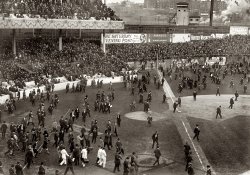
- Sleeping Beauty: 1910
- ... good for him!
No movies - no internet - John in New Orleans again -
I wonder where their ideas for costumes came from. ... We had "moving pictures" as early as the 1890's here in New Orleans, and I know these were "big city" kids with access to these venues, ... Posted by Dave - 08/22/2012 - 8:39pm -
![Sleeping Beauty: 1910 Washington circa 1910. "Congress Heights Dramatic Club." Harris & Ewing Collection glass negative, Library of Congress. View full size.
Nearly ThereDoesn't she sleep for a hundred years? Only a year to go...
CostumesKids had much better costumes in the days when nearly any mother could whip up something fairly elaborate on the home sewing machine.
Posh CostumesWere these Congressmen's kids? Looks like the costume budget was pretty big for an amateur youth theater group. There is evidence that attics had been searched for props, though. That immense Paisley shawl under Sleeping Beauty is of a size worn with Lincoln-era crinolines, but not later.
Gee, I don't know ...all these pictures of prone folks are giving me flashbacks of "playing doctor" when I was a young-un'. Please stop toying with me, Dave; you're playing with fire.
Act 2This is the same backdrop as in "Class Photo."
Wowza.Such beautiful children. Not that kids today aren't cute, but I'm sure they all grew up to be beautiful men and women in their day.
Same old ratioTwo girls for every boy. I guess drama clubs have been like that since Great-Great-Grandma's day.
Jack and JillThe girl on the left is strikingly beautiful. As for the dude wearing fish scales and the lace around his neck; I can just see him arriving at school wearing that outfit and being stopped by the bullies in the schoolyard! But he's a good sport, good for him!
No movies - no internet - John in New Orleans again -
I wonder where their ideas for costumes came from. Books, probably. Most people in 1910 probably didn't have preconceived notions of what medieval costume would have looked like from years of watching movies or Disney cartoons - although I know they had magazines in 1910 with photographs reproduced. I just wonder about stuff like that. Of course without TV and movies and the computer (ahem...) to distract them, they read a great deal more than most of us do today...
And I look at this photograph and wonder about the friendships that were made during the rehearsals of this production and the giggling and fun that went on as they tried on their funny costumes... Where was it staged... what did the cars and carriages look like lined up outside...
[They probably saw some movies. There are hundreds of movie ads in the Washington Post archives from 1910. Plus there were plays, opera houses, vaudeville. - Dave]
Sly smileSleeping Beauty is smiling slightly because she knows any second she's gonna get a big wet one!
That GirlThat beautiful young lady could be the model for every interpretation of an Angel ever painted. Wonderful picture!
Costume History BooksIn addition to theater productions and the early movies, there were numerous well illustrated books on historical costume that would have been readily available in Washington schools and libraries. One very popular source was The History of Costume by Braun & Schneider, published serially in Germany from 1861 to 1880, and widely reprinted ever since. Such resources added a level of authenticity to the look of historical genre paintings, theater and opera productions, and the early movies. And, textile mills here and in Europe churned out reproductions of historical textiles and trims from many periods for popular revival styles in fashion, architecture and for churches. It looks like Sleeping Beauty's handmaidens had seen Plate 15b in Braun & Schneider, among other images. This plate is reproduced online at
http://www.siue.edu/COSTUMES/PLATE15BX.HTML
That's interesting!I knew they had movies then, but I hadn't realized that they were as widely available as they were, judging from these ads. We had "moving pictures" as early as the 1890's here in New Orleans, and I know these were "big city" kids with access to these venues, but I guess I always think of silent movies as something out of the 1920's - and then "talkies" from the late 20's and 30's. So much change going on right before WWI... I'd like to know more about their world.
Pre-RaphaelitesAbsolutely gorgeous! Reminds me of a Burne-Jones painting. If
anything, the variety of faces actually improves on, say, a Waterhouse
or Burne-Jones image, which tended to feature one type of face
serially.
Costume imageryIt wouldn't have been necessary to do much research to come up with costumes like this; in fact I'm sure the look wasn't at all unfamiliar to these kids, since this period was justifiably termed the "Golden Age of Illustration." Books of fairy tales, myths and adventure stories aimed at younger readers were filled with full-color paintings by such illustrators as N.C. Wyeth, Arthur Rackham and Edmund Dulac. Though from 1924, the Wyeth Charlemagne illustration below is typical of what was being done during this period.
Time didn't flyAfter perusing the excellent reference provided by A.T. at 3:58 am, I was surprised at how slowly fashions changed then. Now, we can recognize the 1920's, 1930's, etc. with no problem. Most interesting is that the men started exposing more and more lower body and the women continued to wear long skirts well into the 20th century. Except for the military, hats eeemed to have disappeared altogether just within the last 50 years.
This looks familiar... I'm currently stage managing a production of "Camelot." These costumes would fit right in. The kneeling prince even has a sword and tights. I love that the king has that elaborate chain of office, but his crown is rather simple.
Jack and JillI am struck by the fact that this photo looks like the Sleeping Beauty tableau described in Louisa May Alcott's book "Jack and Jill." I wonder if any of children (especially the girls) read the book and set themselves up in the same way.
Harry ChickI normally hate topic drift but my mind is completely befuddled by the Plaza Theater's "Harry Chick in Songs" ..... something to do with Ag's mechanical demo hen we saw earlier (tomorrow?)
[The tenor Harry Chick was billed as "Washington's sweetest songster." - Dave]
(The Gallery, D.C., Harris + Ewing, Kids)](https://www.shorpy.com/files/images/14907a.thumbnail.jpg)
- Water Avenue: 1935
- ... first image on the top and I said to myself "nice photo of New Orleans French Quarter", then quickly read that it is instead Selma, ... Then, I scrolled down to the next photo, and it's New Orleans! And on top of that, I wouldn't have guessed it by looking.
... Posted by Dave - 01/14/2023 - 11:37am -
![Water Avenue: 1935 December 1935. "Main street architecture. Selma, Alabama." Premises of the Cotton Exchange and L.C. Adler & Co. furniture store. Note the fire bell tower at right. 8x10 inch nitrate negative by Walker Evans for the U.S. Resettlement Administration. View full size.
FiligreeThe word comes to mind when I look at the fine metalwork of that attractive upper gallery. I know it’s used more with regard to jewelry, but we are allowed to use it when talking about metalwork and wrought iron, too. I also think of lace.
Period architectural detailsIt's interesting to see the quoins (corner blocks/stones) on the brick building. It's hard to see in the shadows, but it looks like arched windows on the second story. The ventilator grilles above each window are an interesting Southern architecture touch. What's not clear to me is the window/door header on the ground floor above the row of doors/windows. There might be arches hidden behind the porch, or this might have a iron/steel beam as a header. If the latter, I'd tend to date this to early 20th century, if the former, then earlier. And if later, the quoins and similar detail along the ground floor doors could be cast concrete, rather than stone. The porch posts are most likely cast iron.
I hope someone has some more history on this building.
Sort of survived
Head bangersThose low hanging light bulbs in the furniture store appear to be ... low hanging. You would think any one of those chairs they're selling would give a person some extra height so they could change a burned out bulb.
Architecture/geography coincidenceWhen I opened Shorpy just now, this was the first image on the top and I said to myself "nice photo of New Orleans French Quarter", then quickly read that it is instead Selma, Alabama. Then, I scrolled down to the next photo, and it's New Orleans! And on top of that, I wouldn't have guessed it by looking.
Still there, maybeIf the recent tornado that ravished the Selma area missed this old building then it is still there.
[You haven't been ravished until you've been ravished by a tornado. - Dave]
Someone stole my balconiesPlease bring them back!
The building (1225 Water Avenue) is still extant, and, up until a few years ago (above) looked little different than in 1935. The most recent Street Views show the ironwork missing. Hopefully they just sent it out to be cleaned.
The historical survey of the building is rather brief: "1223-5 Water Ave. c 1860-70. Italianate. Two-story, two-bay brick two-part commercial block ... Cast iron quoins."
I just knew ...... this was a Walker Evans photograph before reading the caption.
[Taken almost 90 years ago, but digitized and made available online by the Library of Congress only last fall. - Dave]
(The Gallery, Stores & Markets, Walker Evans)](https://www.shorpy.com/files/images/SHORPY-8c52069a.thumbnail.jpg)
- A Place in the Sun: 1936
- January 1936. "Negro house. New Orleans, Louisiana." The abode last glimpsed here . 8x10 inch nitrate ... around so the back faces the wall!
(The Gallery, Kids, New Orleans, Walker Evans) ... Posted by Dave - 01/14/2023 - 6:12pm -
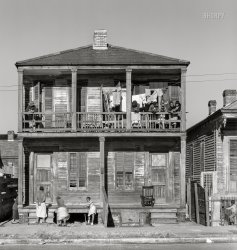
- The Matrix: 1907
- New Orleans, Louisiana, circa 1907. "Canal Street." Life on the grid a century ... is doing is reading. - Dave]
Streetcar Remnants New Orleans once sprawling streetcar system has been reduced to two lines, ... see in the modern photo) and St. Charles Avenue (the old New Orleans & Carrollton Railway, in service since 1835). That said, there ... Posted by Dave - 07/19/2012 - 4:35pm -
![The Matrix: 1907 New Orleans, Louisiana, circa 1907. "Canal Street." Life on the grid a century ago. 8x10 inch dry plate glass negative, Detroit Publishing Company. View full size.
+101Here is the identical view looking up (roughly west) Canal from just below Camp (on the left)/Chartres (on the right) Street taken in September of 2008.
Five sets of streetcar tracksAnd now there are two. The palm trees and street lights are a beautiful addition to this famous street.
Old Familiar NamesI see two store names that I know very well and used to shop at from time to time at their sister stores in Baton Rouge -- Godchaux and Werlein. Godchaux's was a high end department store and Werlein's sold musical products, specializing in pianos. Neither store, to my knowledge, is in business any longer.
Praying or drunk?The man on the right behind the horse and cart holding onto the lamp standard from some reason best known to himself.
[Look closely and you'll see that it's not a lamppost. And that what the man is doing is reading. - Dave]
Streetcar RemnantsNew Orleans once sprawling streetcar system has been reduced to two lines, Canal Street (which we see in the modern photo) and St. Charles Avenue (the old New Orleans & Carrollton Railway, in service since 1835). That said, there are still relics of lines abandoned over 70 years ago, namely Prytania Street.
This site shows some of the remnants of these long-abandoned lines: http://www.streetcarmike.com/nopsi_artifacts.html.
Sadly, Google Street View hasn't made it to New Orleans yet and photos of all the patches and rail visible on lower Prytania (a line that was torn out in 1932!) don't seem to be online at this time.
[Street View is available for almost all of New Orleans. - Dave]
View Larger Map
Only two years after Groucho joined the troupe.And the Marx Brothers already dominated the theatrical marquee. According to Wikipedia, at that time they were purely a musical group.
[Marx Bros. was a dry-goods store on Canal Street ("Furnishers & Hatters, Leaders in Low Prices"). - Dave]
I see "Annunciation"But where is "Desire"?
Actually three car lines nowThe Riverfront line was created in 1988, long before the Canal line was restored. It was partly as an attraction for 1988 Republican National Convention.
(The Gallery, DPC, New Orleans, Stores & Markets, Streetcars)](https://www.shorpy.com/files/images/4a13821a.thumbnail.jpg)
- Liberty Theatre: 1935
- ... "1935 or 1936. Saint Charles Street. Liberty Theatre, New Orleans." Now playing: Wheeler and Woolsey in "The Rainmakers," with a ... street car to and from work.
(The Gallery, Movies, New Orleans, Walker Evans) ... Posted by Dave - 09/12/2011 - 4:58pm -
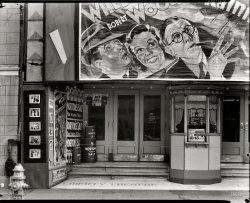
- Hello Lamppost: 1926
- ... my wife and I just saw Simon and Garfunkel at Jazz Fest in New Orleans this past weekend.
Hello Lamppost: ... feelin' not so ... Posted by Dave - 07/24/2012 - 9:51pm -
![Hello Lamppost: 1926 Washington, D.C., circa 1926. "Auto accident." With no shortage of witnesses. National Photo Company Collection glass negative. View full size.
Maybethe lamppost ran out and jumped on him?
Celebrity WatchIsn't that George Costanza standing next to the cop on the extreme left of the picture?
Slow Down, You Move Too FastThe missing running board and dented passenger door seem to indicate that a side impact threw this Durant into the lamppost. Some other car apparently came kicking down the cobble stones.
How appropriate a headline, too, as my wife and I just saw Simon and Garfunkel at Jazz Fest in New Orleans this past weekend.
Hello Lamppost:... feelin' not so groovy!
Whatcha knowin'?He may have even kicked down a few cobblestones.
The good old daysThere was less government encroachment on personal liberty in the "good old days." That driver will be able to feel the effects of the accident for some time to come: he may even have scars or bruises to show family and friends. Today, however, the government requires us to wear seat belts: what a bummer.
[And our insurance premiums help pay for the liberty of you who choose not to. - Dave]
RubberneckingA good accident never fails to draw the attention of surrounding people. It is so interesting that boys would rather watch than play baseball!
That tire on the groundis pretty thin!
High mileageThat certainly was a well worn tire that was knocked off the car. Maybe a blowout was the cause of the accident in the first place.
Front EndHey, is that an indepentdent double wishbone suspension with anti-lock brakes and electronic stability control?
The air bag didn't deployDurant is in big trouble now!
Accidentes de tráficoNow climbing the charts at meneame.net.
(The Gallery, Cars, Trucks, Buses, D.C., Natl Photo)](https://www.shorpy.com/files/images/16125u.thumbnail.jpg)
- Triple Feature: 1939
- ... the call - the last place I saw a nickel pay phone was in New Orleans in 1977.
On the horizon I wonder how old the guy is on the ... Posted by Dave - 05/02/2012 - 9:54pm -
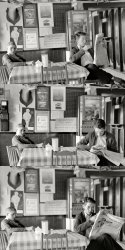
- Best Beer in Town: 1937
- New Orleans, Louisiana, circa 1937. "Tortorich Restaurant, Royal Street." 8x10 ... myth). The bitters are still around, and the Sazerac is a New Orleans favorite.
If its appropriate, here's the recipe:
2 ounces ... and St. Louis.
Of Tortorich Restaurant, the 1938 WPA New Orleans City Guide says: "well known for Italian food and seafood ... Posted by Dave - 08/11/2012 - 11:50am -
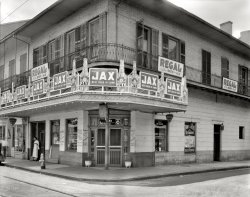
- Room and Bird: 1936
- January 1936. "New Orleans architecture. Cast-iron grillwork house near Lee Circle on Saint ... a bird in a gilded cage"
Bebop on down to Birdland New Orleans. Jazz. SAINT CHARLES. Who needs a gilded cage?
Am I Psyhic or ... mercy.
When I see pictures of the glorious past of New Orleans, my first thought is: How in the living hell did they stand the ... Posted by Dave - 07/19/2012 - 4:31pm -
![Room and Bird: 1936 January 1936. "New Orleans architecture. Cast-iron grillwork house near Lee Circle on Saint Charles Avenue." Large-format nitrate negative by Walker Evans for the Farm Security Administration. View full size.
$2I forgot to make reservations this year for the Mardi Gras parades, do you think I can still get the advertised rate?
TweetDid anyone else search every square inch of the grillwork looking for the bird?
[Hello? They're right in front of your nose. - Dave]
Re: TweetI, too, searched for the elusive bird, never thinking to look IN the window. Guess my super-sleuthing abilities are somewhat less than super.
Conservative Chimney...It leans to the right.
And it's singing . . "I'm only a bird in a gilded cage"
Bebop on down to BirdlandNew Orleans. Jazz. SAINT CHARLES. Who needs a gilded cage?
Am I Psyhic or PsychoThis image looks to me to be a repeat. The frontal scene and especially the ornate grillwork struck a memory chord. However, I searched Shorpy using various combinations of caption words or phrases (cast-iron, grillwork, ornate, etc.) to no avail.
Is this the same of smilar to a posted picture in, say, the past 6 months? (Should I mention that I have been having vivid and interesting dreams of late?)
[Did you search for "Orleans"? - Dave]
Chez IgnatiusSweet mercy.
When I see pictures of the glorious past of New Orleans, my first thought is: How in the living hell did they stand the heat in the summer?
Yes, I know. As my mother whose clan is from New Orleans says, they were much tougher folks in those bygone days.
I just bet they were. But I guarantee I smell better than any of them after a long, sticky, hot summer night spent in my air conditioned home rather than sprawled out on the front porch because it was too damn hot to sleep inside.
Motel 2The $2 room is the one overhanging the alleyway with floor about to give way and wrapped in high-voltage wiring!
Lake PontchartrainIn a gentler time, during the New Orleans summer, thousands of people would sleep out on the south shore of Lake Pontchartrain.
(The Gallery, New Orleans, Walker Evans)](https://www.shorpy.com/files/images/8c52099u.thumbnail.jpg)
- French Market: 1910
- New Orleans circa 1910. "A corner of the French Market." At the produce stand ... you mean "women." - Dave]
(The Gallery, DPC, Kids, New Orleans, Stores & Markets) ... Posted by Dave - 07/19/2012 - 4:31pm -
![French Market: 1910 New Orleans circa 1910. "A corner of the French Market." At the produce stand of Gus Clesi & Bro. Detroit Publishing Company glass negative. View full size.
Burrita.Increíble cantidad de información, preciosa foto.
El grupo de chavales mirando al fotógrafo, displicentes, es un mundo aparte dentro del entorno urbano.
Extraña manera de pasar el arnés por detrás del rabo de la burra ...
Tough GroupI'm sure it was a tough time to be a kid, and their faces reflect it. It seems the kids in all of these turn of the century photos have the same expression. I especially like little Ross Perot on the far left. Those are some impressive ears.
French Market: NowView Larger Map
The Three Stooges!Those three kids in the back of the cart. It's Curly, Larry and Moe! Woo-woo.
If you look closely at the street...that place has got to smell pretty bad. I mean, barnyard bad.
The Little RascalsThis pictures conjures up Our Gang, of The Little Rascals fame. Alfalfa must be the tall skinny boy on the right.
Hatsville USAThe woman in the background has a hat.
The man in the background has a hat.
All of the little boys are wearing hats--except for one.
The little bald boy, who is the only kid who has any need for a hat, has none.
Go figure.
Sorriso? Perché?A bit of unrelated triva (the "DeLuca Hardware" sign set me off): By 1910, the population of the French Quarter was 80 percent Sicilian, with the greatest concentration of Italian families living in the Lower Quarter, between St. Ann and Esplanade. Businesses in and around the French Market would have taken full advantage of cheap Italian labor, and I'm guessing that at least two of these tired-looking kids are Italian.
In this photo from the Louisiana Digital Library, the woman in the black dress with white hair pulled back in a bun may or may not be a Sicilian grandmother, but I'd like to think that she is. The photo is titled simply "Courtyard on Chartres Street."
Meanwhile. . . . . . . . elsewhere in the city, nine-year-old Louis Armstrong is attending the Fisk School for Boys and picking up extra money for Mom as a paperboy and other menial jobs, which didn't keep her from resorting to prostitution now and then. He didn't pick up a horn for a couple more years.
Peel outYes, we have mo' bananas!
Mamma MiaNot only Italian, but the way she is dressed, appears to be widowed as well.
A shaved headsometimes indicated a "nit" problem,
no hat = infested hat.
Black, WidowsI don't think the woman is a widow. Widows even today in parts of Italy wear ALL black. No white dresses. Never.
[Not sure I get the logic here. Or do you mean "women." - Dave]
(The Gallery, DPC, Kids, New Orleans, Stores & Markets)](https://www.shorpy.com/files/images/4a19876u.thumbnail.jpg)
- Caprine Caper: 1904
- ... not the heat ... it's the stupidity. Or so they say in New Orleans. In this case, I'm betting it was a hot, humid day. The squinty ... Posted by Dave - 12/08/2022 - 10:44am -
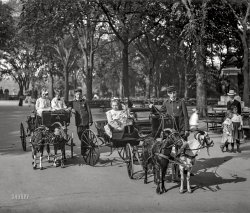
- Royal Street: 1906
- New Orleans circa 1906. "Royal Street from Canal Street." Where the ice man ... Fabacher. His obituary read that his restaurant "meant New Orleans wherever gourmets and epicures gathered." He also founded Jackson ... see one in its original location.
(The Gallery, DPC, New Orleans, Stores & Markets) ... Posted by Dave - 07/19/2012 - 4:34pm -
